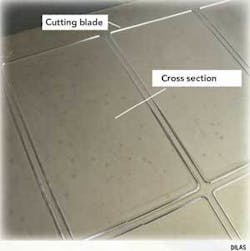A promising tool
High-power diode lasers offer a solution for a number of materials processing applications
High-power diode lasers (HPDLs) have been applied in industry for several years. Apart from the pumping of solid-state lasers they are used in materials processing for welding, soldering, and heat treatment. In the past, multikilowatt systems were of importance for thin-sheet welding or for selective tempering; today more micro applications can be found where HPDLs up to 500 W are used. The higher beam quality and, resulting from this, the small focal diameters make the HPDL a promising tool.
Diode lasers are available for direct processing or as fiber-coupled systems. Lasers for direct processing show a rectangular focal geometry, whereas an axially symmetric beam is typical for fiber-coupled systems (see Figure 1). Within the power range up to 150 W, passively cooled fiber-coupled systems are preferred . The heat developing in the semiconductor is dissipated by a massive cupreous heat sink. For the cooling of the heat sink a thermoelectric element or industrial water cooling can be used.
Passively cooled diode-laser systems are characterized by a compact design and small maintenance requirements. The cooling medium needed for water-cooled diode lasers is not necessary for these passively cooled diode lasers.
In most cases the massive heat sink doesn’t allow the use of passively cooled diode lasers as a direct beam source, so the laser radiation is coupled into fibers with 400- to 800-µm core diameters. The focal diameters achieved with such systems are approximately 600 µm or 1200 µm at a working distance of 100 mm. For special applications it is also possible to use smaller focal diameters with limited laser power. Due to the high beam quality of the diode-laser elements used, it is possible to get about 22 W of laser power with a 200-µm fiber on the workpiece. By using a shorter focal length, a focal diameter of around 120 µm can be achieved.
Actively cooled diode lasers for direct processing are used if laser power of more than 150 W is required. The quality of the cooling water then becomes very important. All relevant properties have to be surveyed by integrated sensors to ensure undisturbed operation.
Applications and possibilities
Apart from the technical design of the diodes the application determines focal spot size and geometry. A line focus is often more advantageous for heat treatment than a round spot. Contour welding with a rectangular focus is only possible within narrow limits. The compact design of the diode lasers enables the integration of sensors for process control in the focusing head. Pyrometers and CCD cameras are helpful tools for setup, control, and documentation of manufacturing processes. It is even possible to compensate failures and thus stabilize the manufacturing process.1
In the last few years laser-transmission welding of polymers has gained in importance. The nontactile energy input and the small heat-affected zone are advantages of laser welding compared to conventional methods such as heated tool welding, ultrasonic welding, or vibration welding. Depending on the application, different concepts such as mask welding, contour welding, simultaneous welding, or quasi-simultaneous welding are used.2 The high beam quality of the fiber-coupled diodes allows the use of scanning optics for quasi-simultaneous welding.
In polymer welding, the wavelength of the laser radiation is very important. Absorption is determined in most cases by additives implemented in the plastic, for example, pigments or colorings, and not by the polymer matrix. Polymer producers offer a large variety of different colored plastics that can be used for laser transmission welding. These additives show mostly narrow-bandwidth absorption maxima that don’t cover the whole spectrum of the available standard wavelengths (808, 940, and 960 nm).3
Heat treatment of metals was the first application of HPDLs in industrial situations. Examples are hardening of guide bars and heat treatment of torsion springs,4 where the locally limited and controlled heat input is a great advantage. With today’s HPDLs, it is possible to treat even very small contours with good accuracy that offers a variety of interesting possibilities.
For label production, stamping tools with micro cutting edges are integrated into printing machines. These cutting edges have to be hardened without heating the backing material. To achieve homogeneous hardening a HPDL with an integrated pyrometer is used. The laser system operates in a closed loop to keep the temperature on the knife edge constant (see Figure 2).
Tungsten wires with diameters between 100 and 600 µm have to be reshaped when manufacturing filaments for lamps. Tungsten, however, is a very brittle material that needs to be annealed during the shaping. While the wire gets heated it has to be covered with a shielding gas. With a HPDL it is possible to heat the wires in a closed-loop process up to the annealing temperature without thermal damaging the shaping tools.
Laser soldering is a selective processing technique that is used in electronics production for soldering contacts, sensors, and switches. The advantages of this method are nontactile heating, limited heat load, a highly defined energy input, and good accessibility. Laser soldering is used when the thermal impact on surrounding components has to be avoided or when the components themselves are sensitive to heat. An example is the contacting of flexible printed circuits (FPCs; see Figure 3). FPCs are used increasingly in the automotive and electronics industry. Overheating leads to delaminating of the polymer compound and destroys the part.
The locally limited energy input allows the soldering of very small components such as a semiconductor that has to be contacted to a thin copper wire. The diameter of the wire is 75 µm. The pads on the semiconductor are gold plated and have a size of 400 × 800 µm. Due to the production process it is not possible to apply solid solder deposits or soldering paste; therefore, solder wire with a diameter of 300 µm is used. The focus of the laser beam has to be accurately adjusted to the pad because the plastic housing is a good absorber of laser radiation. Visual inspection of the solder joint shows it is free from defects and x-ray inspection shows no porosity or imperfections.
Perspectives and trends
Over the last few years developers of diode-laser systems tried to set records in output power and/or beam quality. As the number of laser systems used in industrial production increased, other properties became more important. Greater laser availability, easy maintenance, and industrial design are now more the focus of the suppliers, while the cost of ownership should be on a low level. The reliability of the semiconductors and assembly techniques are very important to fulfill these demands from the market.5
The first HPDL systems had no sensors integrated, but today nearly all relevant system parameters are surveyed (cooling conditions, humidity inside the laser module). In the processing head the number of integrated process-monitoring devices like CCD cameras or pyrometers is increasing. The implementation of power measurement and remote diagnosis are also available and will be a standard in the near future. Lasers with a large number of diodes have increased their reliability by using intelligent stack management that allows production to continue even when single diodes fail.
Available systems cover a wide range of possible applications. If this is not sufficient for certain products, customized solutions based on standard diode modules can be offered. An example of this is the multifocus system, which allows simultaneously generating up to four soldering joints or welding seams with only one processing head (see Figure 4). The distance between the spots and their alignment can be determined in a wide range.
HPDLs up to 500W power offer solutions to a wide range of applications. Their small focus dimensions allow machining areas of a few hundred microns. Plastic welding, soldering, and heat treatment are processes with a high potential in the automotive industry, medical devices, and electronic production. The monitoring of operation and process parameters increases the reliability for industrial application.
Wolfgang Horn ([email protected]) is in charge of service and application for Dilas Diode Laser (www.dilas.com).
References
- W. Horn, “Laser beam soldering with pyrometer,” Diode Laser Workshop, Dresden, Germany, Fraunhofer Institute for Material and Beam Technology IWS, 2004.
- J. Chen and C. Thielen, “Globo Welding,” Laser Technik Journal, February 2004.
- BASF, Treffert, and Rofin, “Polymer welding with laser,” Laser Technik Journal, January 2005.
- F. Bachmann, “High power diode lasers for materials processing,” Physikalische Blätter, March 2001.
- J. Neukum, G. Seibold, “High power diode lasers-criteria for securing reliability,” DiodeLlaser Workshop, Dresden, Germany, Fraunhofer Institute for Material and Beam Technology, IWS, 2004.





